Funny Little Kid on Bike How Fast Were You Goind 10 Speed
Wondering how to teach your kid to ride a bike? Whether your child is brand new to a bike, is ready to get off of training wheels, or is struggling to transition from a balance bike to a pedal bike, there's a simple and stress-free method to teach your child to ride! It doesn't involve training wheels, and it doesn't involve you running behind them while you hold onto the bike's saddle!
Some kids need help with the whole process, while others (usually balance bike graduates) simply need help understanding how to pedal forward. These are two different problems with two different solutions!
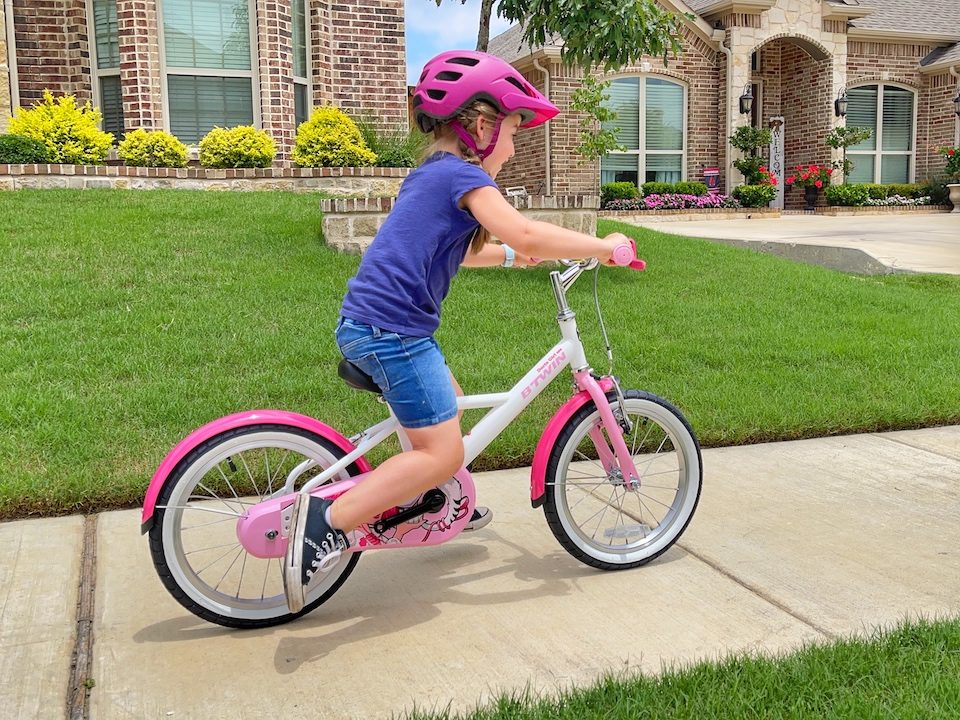
Which Scenario Describes You?
(Click the "Problem" below to skip forward)
PROBLEM 1: My child can't ride a bike at all and I need help!
PROBLEM 2: My child can balance on a bike, but just can't pedal forward.
Teaching Your Kid to Ride a Bike Can Be Easy!
If your child is new to a bike, you can get your child off and riding in no time. Here's the secret – simply take the pedals off of your child's bike and use it as a balance bike!
This simple method allows a child to focus on learning to balance on two wheels, which is the most important skill in learning to ride. A child can learn to pedal later… BALANCE FIRST!
As a result, the fastest, easiest, and most effective way to teach your child to ride a bike is simply by taking the pedals off their bike so they can focus on balancing, rather than pedaling.
This "take the pedals off" method works best for 16″ bikes and larger, but can also be used on smaller bikes. If your child is currently on a 12″ or 14″ pedal bike, considering buying a balance bike instead (there are many great balance bike options under $100), but this method works great as well.
Getting Started – Suggestions for Success
While using a pedal bike as a balance bike is a simple method, there are a few key things to know before you dive in. Here are four pieces of advice that will ensure a smooth and happy process.
- FEET FLAT: A child should be able to touch the ground with their feet flat while sitting on the saddle. This will allow them to push off the ground to gain momentum, and also stop and start the bike independently and safely.
- LOW SADDLE: If a child can only reach the ground with their tip toes, this method will be harder for them. If the saddle isn't low enough, you can try removing the rear reflector from the seat post.
- LIGHTWEIGHT: This method is much easier if the bike is lightweight. True balance bikes are usually under 10 pounds. Heavier pedal bikes make learning to balance more difficult. If your child's bike is heavy, you many want to try to borrow a lighter bike from a friend.
- PATIENCE!: Your child's success and how long it will take them to master a pedal bike ishighlydependent on their athletic ability, determination, and confidence when trying new things. This method could take less than 10 minutes for a confident, athletic child, while it could take a timid child weeks or even months.
How to Turn a Bike into a Temporary Balance Bike
Let's get those pedals off and outline how to instruct your child to use their new "balance bike"!
STEP 1: Remove the Pedals
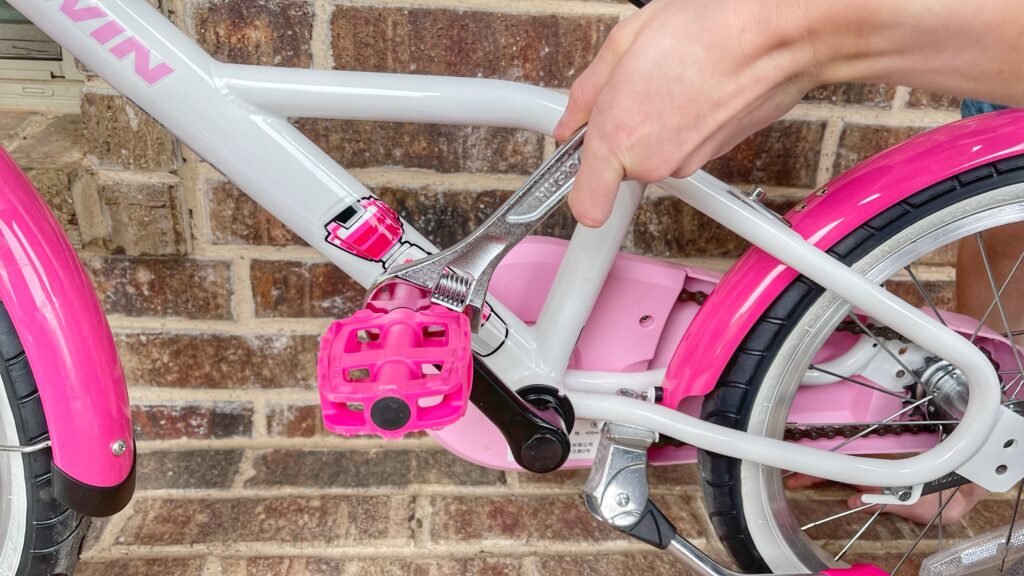
While this step isn't absolutely required, it will make the learning process a whole lot easier for your child. Using a wrench, you'll remove both the pedals from the crank arms of your child's bike.

Here are a few important things to note:
- The left and right pedals are threaded in opposite directions. The right pedal is threaded normally – turn counterclockwise to loosen. The left pedal is threaded in reverse – turn clockwise to loosen
- Using a piece of tape, mark the pedals with an L and R so that you know which is which when you need to put them back on. (Left is left foot, right is right foot.)
- If you forget, there may be an L or a R somewhere on the pedal. If not, the left pedal usually has some sort of marking on it – a line on the spindle or other markings.The left pedal below is both marked "left" and has lines on the spindle.
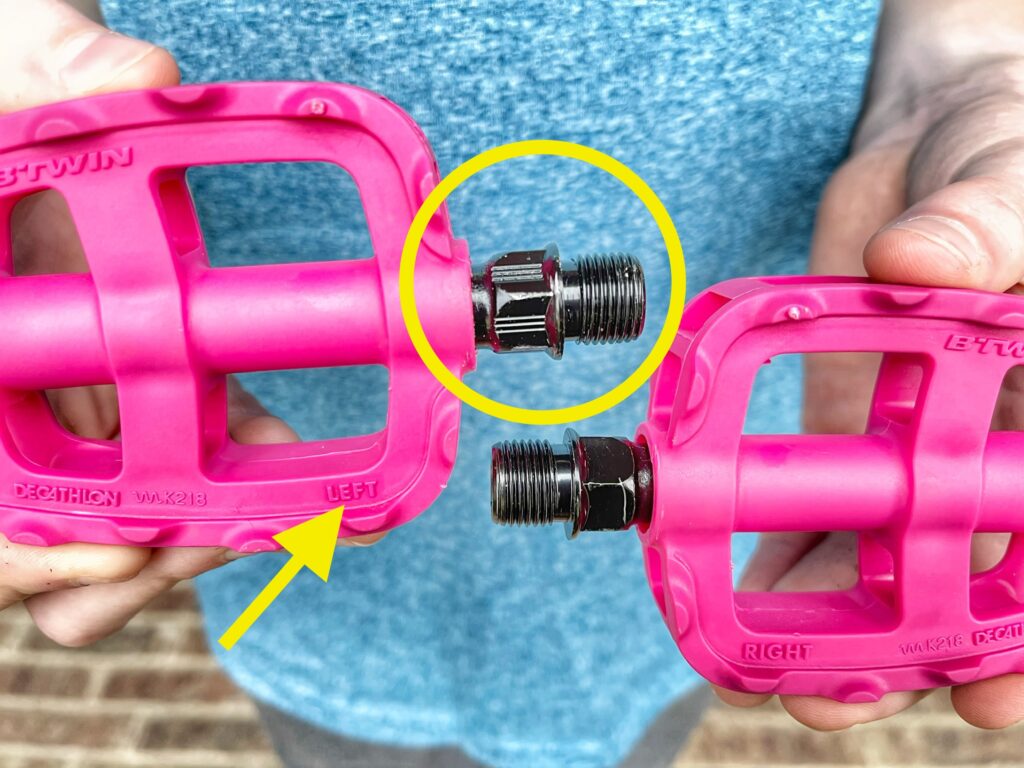
STEP 2: Leave the Crank Arms
While in a perfect world you would also remove the crank arms, this is a difficult and sometimes an impossible process. We've found that removing just the pedals works fine and the crank arms generally don't get in the way of your child's legs while they are learning to ride a bike.

Be aware that if you have a cheaper bike, the distance between the pedals may be very wide. This means that your child would have more difficulty using it as a balance bike because their legs will be spread wider than is natural to walk or run. Depending on how wide the bike is, the crank arms of the bike could possibly hit their legs.
Narrow Kids Bike vs. Wide Kids Bike

STEP 3: Set the Seat Height Properly
The bike's seat should be set so a child's feet can be flat on the ground when sitting on the saddle, ideally with a slight knee bend (if the seat can go that low). If this isn't possible, remove the rear reflector to set the seat as low as possible.

STEP 4: Sit and Walk
How to teach a child to ride a bike really starts here! Have your child sit on the seat with all of their weight, and use their feet to walk the bike forward.
Remember that through the whole process of learning to ride a bike, your child should be wearing a bike helmet.
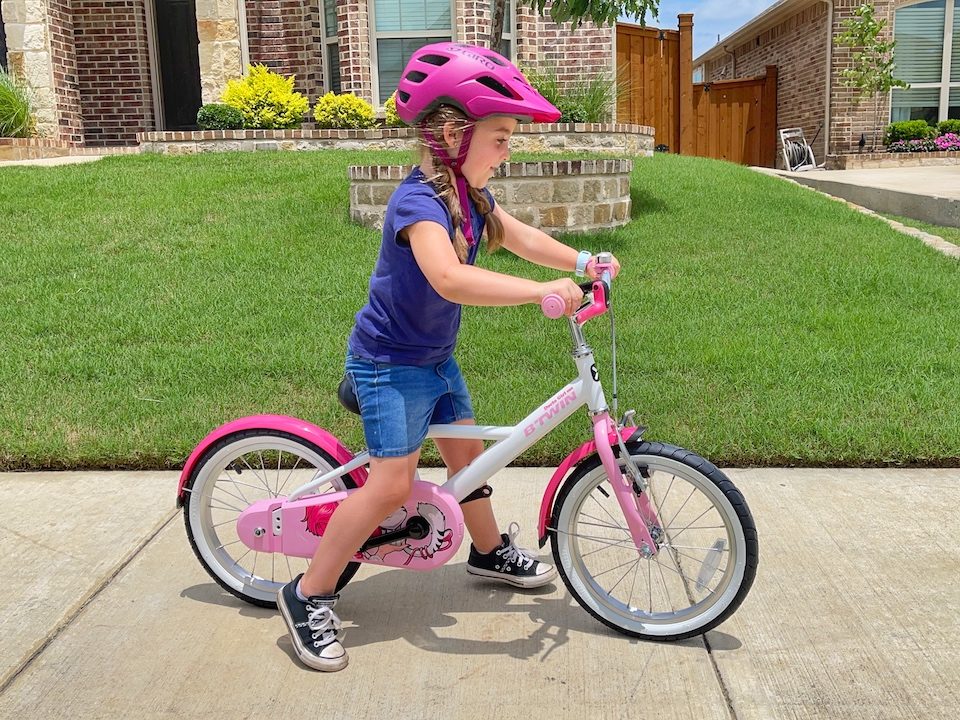
STEP 5: Sit, Run, and Glide
Once the child is comfortable walking slowly on the bike, have them try to run and then eventually glide and balance. If they are struggling with this idea, give them a little help with their momentum.

How? Rolling down driveways or grassy hills is a great way for them to easily pick up speed and learn the feel of gliding and balancing.
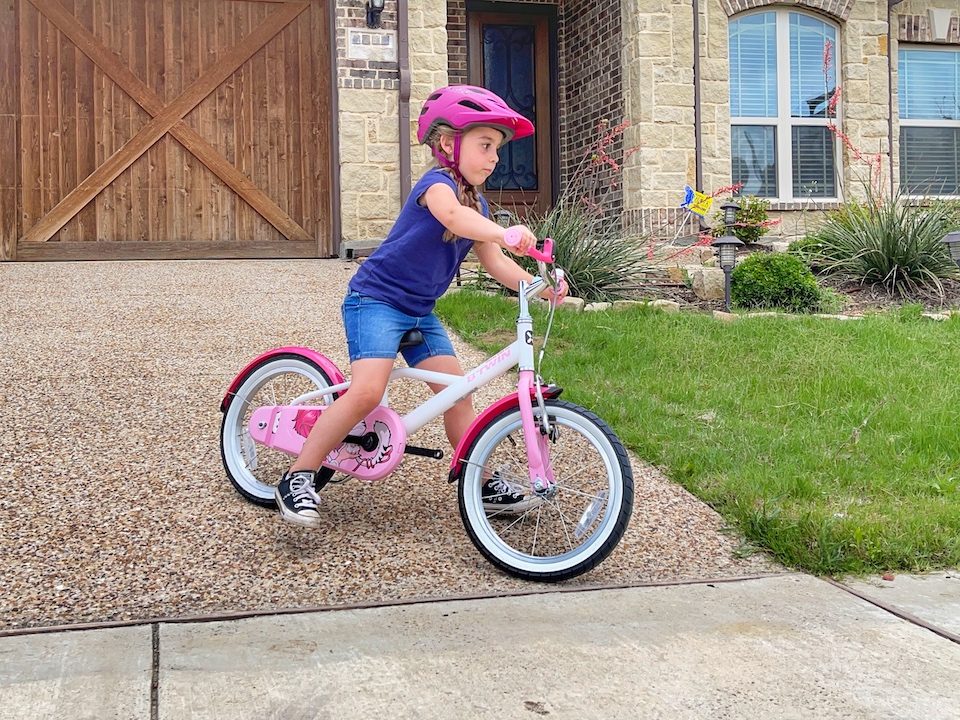
Once they've mastered going in a straight line, your child will need to learn to balance and steer. Have your child work on turns while gliding. They could roll down the hill and then do a slight turn to either side. Learning the feel of how the handlebars react and how to steer the bike when turning during a glide is essential. Most kids pick it up naturally, but some don't, so make sure they practice.
Important Note: If your child's bike has a coaster brake and no handbrakes, the only way they will be able to stop the bike at this stage is with their feet.
STEP 6: Balance Mastery – Don't Rush the Pedals!
Remember, the entire purpose of this exercise is to teach a child to balance on a bike. Don't pressure them to put the pedals back on before they can clearly balance while in motion for long distances, and also comfortably turn the bike while gliding.
Some kids will master this in 10 minutes, while other kids days or weeks. Exercise patience and let the child use the bike as a balance bike as long as they need to!
Turn the Bike Back Into a Pedal Bike and Ride!
When a child has mastered balancing and steering, it's time to put the pedals back on!
STEP 1: Put the Pedals Back On

Using the same wrench as before, put the pedals back on.
- Remember that the pedals are "side specific". Right pedal on the right foot, left pedal on the left foot.
- Right pedal – turn clockwise to tighten. Left pedal – turn counter-clockwise to tighten.
- Pedals can be tricky to get started threading, but never force them or you could strip them. There should be very little resistance to get the pedal started. In the image below, you can see the pedal that has just started threading into the crank arm.

STEP 2: Keep the Saddle Low, But Raise it a Little
After adding the pedals back onto the bike, a child still needs to be able to stop and start the bike with their feet, just like they did while it was a "balance bike". But to allow for more efficient pedaling, you need to raise the seat height so the child can touch the ground with feet flat, but no knee bend.
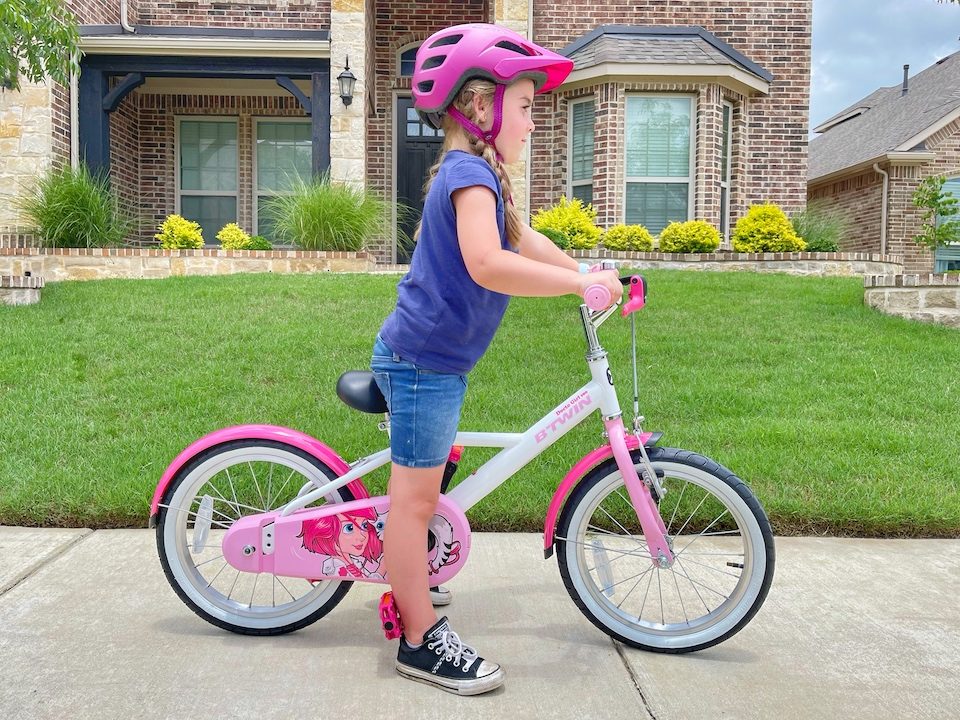
Once they are very confidently pedaling, you can raise the seat height again so they can touch the ground with solid tip toes.
STEP 3: Sit and Gain Momentum
To ride the bike with pedals back on, have your child first run on the bike like they did without the pedals. They will need to place their feet behind the pedals to do this. This is usually easier on a slight decline.

STEP 4: Put Their Feet on the Pedals
Once a child has gained enough momentum, put those feet on the pedals and go!

Important Note: If your child's bike has a coaster brake, getting the pedals into "start position" will be problematic. Additionally, many kids pedal backwards to regain their balance, especially when first learning to ride a bike. A coaster brake will cause the bike to stop when the child pedals backwards.
Having Trouble Balancing and Pedaling at the Same Time?
- If you think your child needs a little help, you can guide them with a gentle hand centered on the shoulders around the neck. Do not try to grab their bike, which will throw off the child's balance.
- A bike is more stable at higher speeds. If a child is slowing down too much, (often due to stopping to look at their feet to figure out pedaling), give them a gentle push on their back to make sure they keep their speed up.
- If this doesn't work, take the pedals back off and give your child more time on their "balance bike". It's okay if your child needs a little more time to learn to ride a bike. And it's also okay if your first effort to teach your child to ride a bike wasn't 100% successful!
How to Help a Child Who Can't Pedal Forward
If your child can't figure out the pedaling motion, this is normal! With most young kids, it's actually more natural for them to pedal backward than it is forward. So while learning to pedal, it is very common for kids to get confused and pedal forward and then backward and then forward again!
Use a Trainer to Learn the Pedal Motion
To help kids master the forward motion of pedaling, we've found that the best way is to use or build a "bike trainer" to allow them to only work on pedaling. Without the need to worry about balancing, steering, starting, or stopping, trainers are a quick and easy way to allow kids to focus just on pedaling.
Once you've built your "trainer", kids typically progress pretty quickly. By supporting the front tire (to keep the handlebars from moving) while also lifting the rear tire off the ground, the child pedals without propelling the bike forward.
Trainers are our favorite method because they allow you to stand right next to your child to coach and encourage them as they work through the motions. While some kids just need verbal reminders to push down with their legs, others benefit from an adult putting their hands on their knees to carefully help them through the correct motions.
OPTION 1: Toy Blocks Trainer

The quickest and easiest way to build a "trainer" is to use toy blocks (or other similarly shaped objects). Just stack up the blocks tall enough to prop the rear tire off the ground. This method does require an adult to support the back and the front of the bike to prevent it from falling, but it's quick and easy and kids usually learn the motion of pedaling pretty fast. This method is also a winner because it works on any bike!
OPTION 2: Training Wheels Trainer
If your child's bike came with training wheels, you can use them to help practice pedaling. Just set the training wheels to their lowest setting and then prop up the training wheels with bricks or a small block of wood (unless your bike's training wheel will mount lower than the back tire – which is rare).
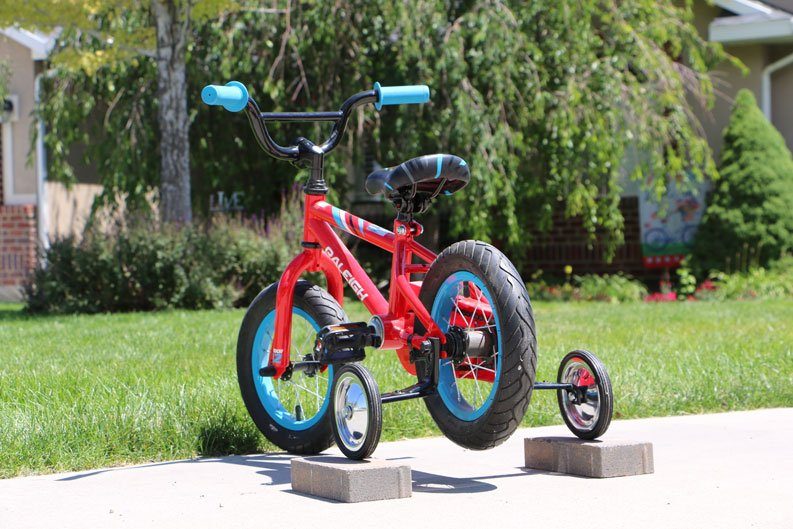
Like the DIY trainer, this method will require an adult to hold the handlebars and the back of the seat to keep the bike stable.
OPTION 3: Balance Buddy "Trainer"
The Balance Buddy is a handlebar for parents that attaches to the rear axle of a child's bike. While not a true trainer (that allows kids to just work on their pedaling), the Balance Buddy does allow you to hold the child upright as they learn to pedal. If the child accidentally pedals backward (and for some bikes activates the coaster brake) the Balance Buddy allows you prevent them from falling over!
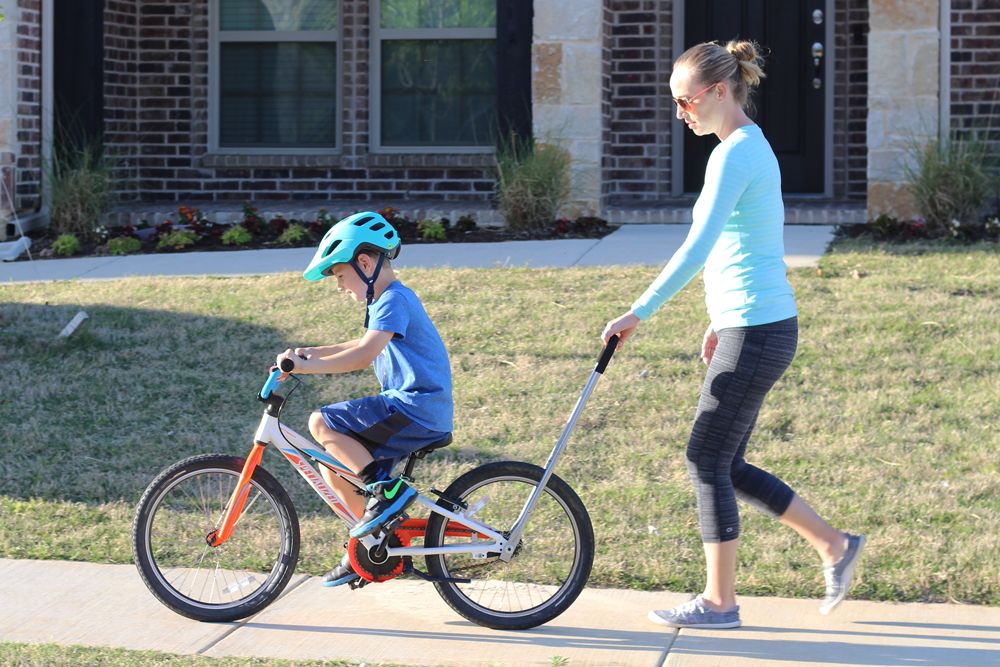
The Balance Buddy also tends to work better on larger 16″ and 20″ bikes as the larger bikes can be more difficult to hold steady on a DIY trainer. The downside of the Balance Buddy is that when the kids pedal, the bikes moves, so the adult helper needs to be able to walk or run along with them.
Teaching a Child to Ride a Bike is Easier than You Think!
How to teach a child to ride a bike doesn't have to be a complicated question or a stressful solution! By following the simple steps outlined in this article, your child will learn to ride a bike – whether in 10 minutes, a week, or 2 months. Just like everything with kids, your little one will master these skills when your child is ready. So get your patience pants on. They can do it… and so can you! 🙂
Related Articles
10 Frequently Asked Questions About Training Wheels
Source: https://www.twowheelingtots.com/how-to-teach-a-child-to-ride-a-bike/
0 Response to "Funny Little Kid on Bike How Fast Were You Goind 10 Speed"
Post a Comment